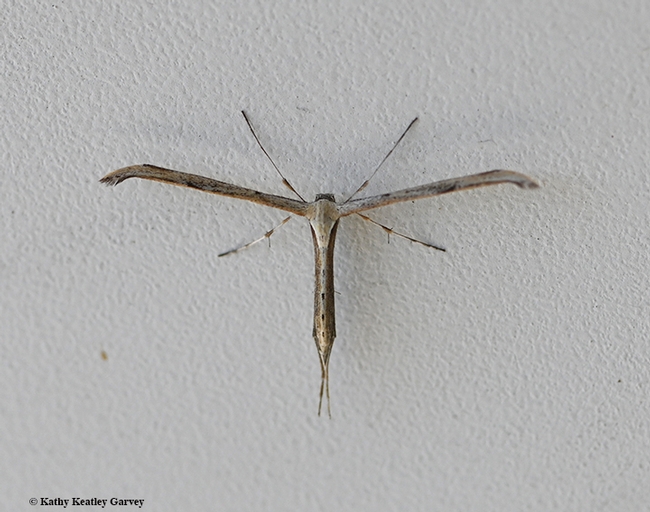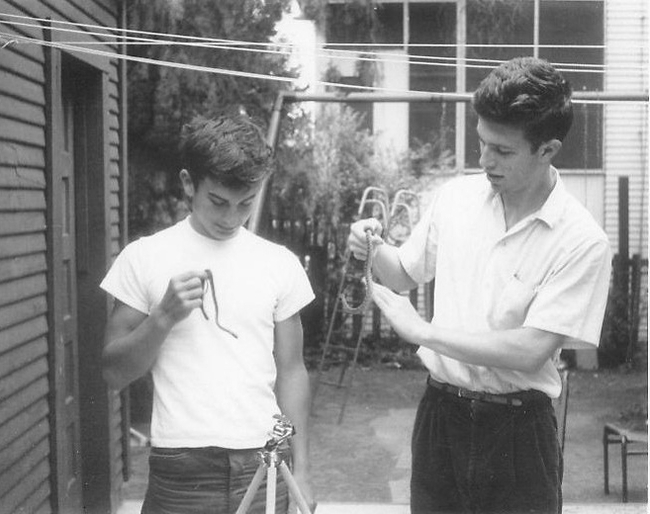- Author: Kathy Keatley Garvey
Let's go mothing!
What's mothing? The National Moth Week website describes mothing as "a hobby for nature enthusiasts who use light or bait to attract moths to a location for observation and data collection."
So, in keeping with National Moth Week, the Bohart Museum of Entomology is hosting its annual Moth Night from 7 to 11 p.m. on Saturday, July 20 at its headquarters in Room 1124 of the Academic Surge Building, 455 Crocker Lane, UC Davis. Outside, Bohart research associate John "Moth Man" De Benedictus will set up a blacklighting display, complete with white sheet and a UV light to attract moths and other night-flying insects.
Inside, Jeff Smith, curator of the Lepidoptera collection at the Bohart, and his colleagues will displays moth specimens and answer questions.
The event is free and family friendly. Tabatha Yang, education and outreach coordinator, says that traditionally, "we serve hot chocolate an cookies."
Have you taken any images of moths lately? In the moth world, we mostly photograph the diurnal or day-flying moths.
Take the plume moth. In his book, California Insects, UC Berkeley entomologist Jerry Powell (1933-2023) explains why they're called plume moths..."because the forewings are deeply notched and the hindwings are divided into three linear parts, each with long scale fringes. When perched, the insects roll the forewings around the folded hindwing plumes, resulting in peculiar sticklike or craneflylike appearance, unlike any other moth." Most are nocturnal and are attracted to lights, Powell adds.
Another example of a moth that flies during the day an night is the white-lined sphinx moth (Hyles lineata).
You'll see those and more at the Bohart Museum's Moth Night.
The Bohart Museum, founded in 1946, houses a global collection of 8 million insect specimens, plus a petting zoo (think Madagascar hissing cockroaches, stick insects and tarantulas) and an insect-themed gift shop. Director is Professor Jason Bond, the Evert and Marion Schlinger Endowed Chair, UC Davis Department of Entomology and Nematology, and associate dean, Agricultural Sciences, UC Davis College of Agricultural and Environmental Sciences.
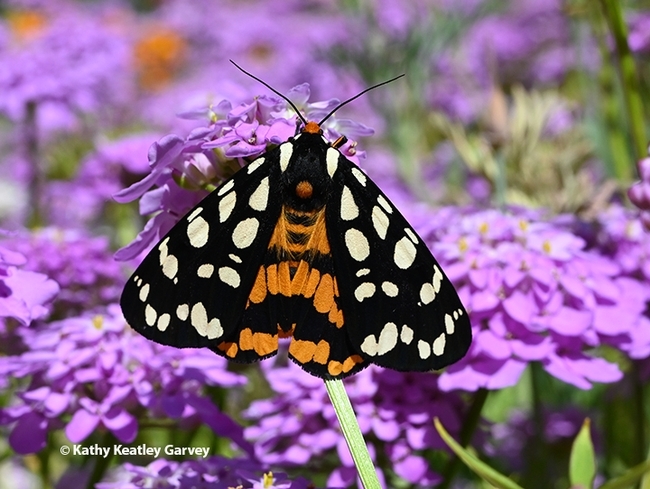
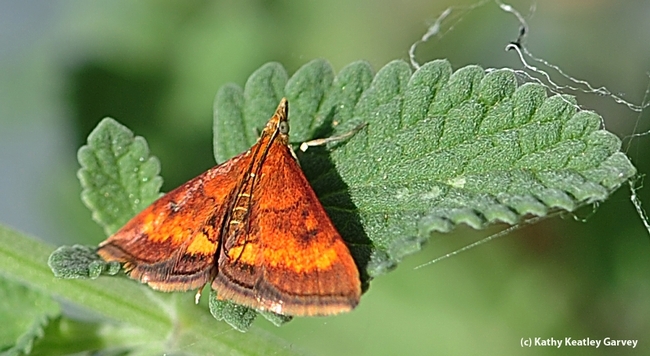
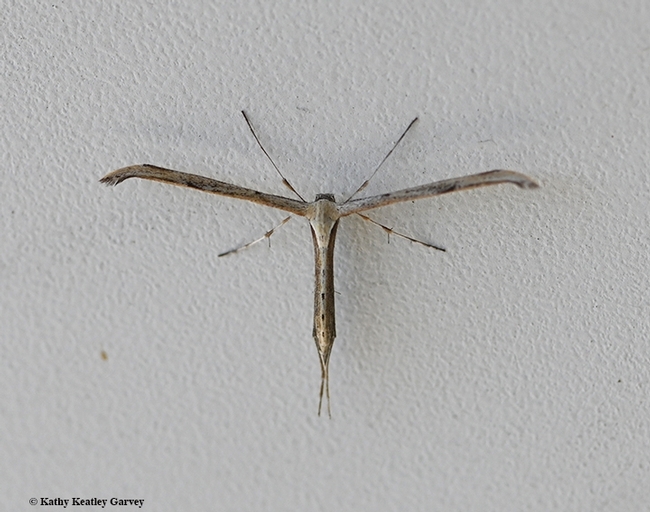
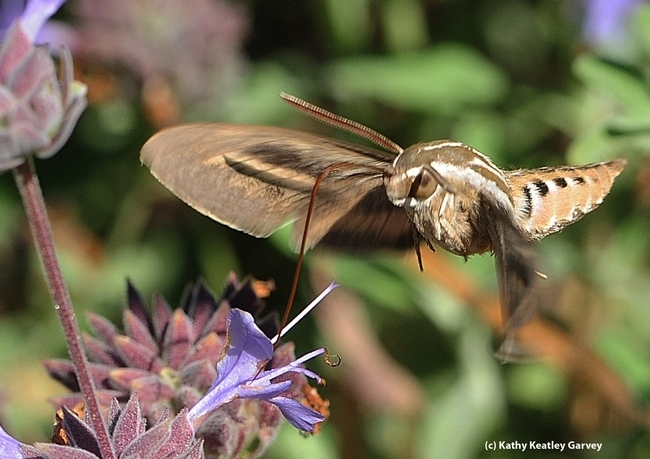
- Author: Kathy Keatley Garvey
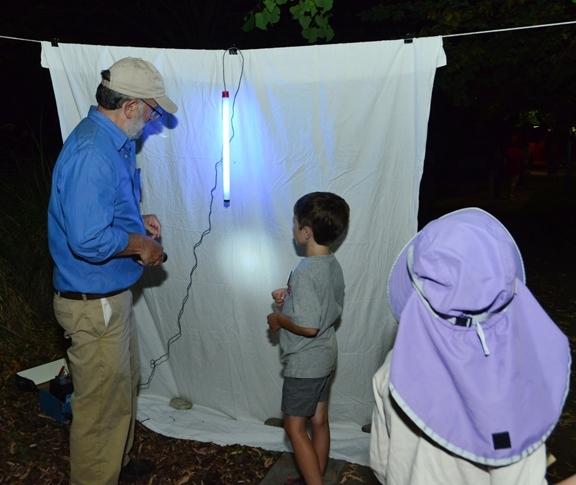
If you attend the Bohart Museum of Entomology's annual Moth Night celebration, affiliated with National Moth Week, you'll meet John De Benedictis, better known as “The Moth Man.”
The indoor-outdoor event, free and open to the public, is set from 7 to 11 p.m., Saturday, July 20 in Room 1124 of the Academic Surge Building, 455 Crocker Lane.
De Benedictis and his colleagues annually set up a blacklighting display, using UV lighting to attract moths and other night-flying insects. He has blacklighted for 37 years.
His moth collection of some 600 species from the Stebbins Cold Canyon Reserve and 300 species from his backyard in Davis is housed in the Bohart Museum.
"Jerry Powell (the late UC Berkeley professor and director of the Essig Museum of Entomology) once estimated that there are about 17,000 North American butterflies and moths," De Benedictus commented. "I would not be surprised if it's closer to 20,000."
'Expertise in Moth Identification Is Invaluable'
"John has been great volunteer and supporter of the Bohart Museum," said UC Davis distinguished emerita professor Lynn Kimsey, former director of the Bohart Museum. "His expertise in moth identification is invaluable and now that Jerry Powell is gone, there's really no one else who can identify moths, particularly little brown moths (LBMs) of California."
De Benedictis, a research associate at the Bohart Museum, is closely linked to UC Berkeley, his alma mater, and UC Davis, where he retired. He holds a bachelor's degree in biology, with an emphasis in entomology (1979), and a master's degree in entomology (1998) from UC Berkeley. "Jerry was my major professor and also recruited me as an undergraduate to work in his lab."
A UC Davis retiree since 2001, De Benedictis worked as a staff research assistant from 1995 to 2001 in the laboratory of medical entomologist Tom Scott, UC Davis Department of Entomology and Nematology.

"I came to Davis in 1989 for a two-month job to key out aphids for Beth Grafton-Cardwell, who at that time was a postdoc of (Professor) Jeffrey Granett. During that time, the rootstock that was being used to protect wine grapevines from grape phylloxera began to fail in Napa and Sonoma counties, so I was able to prolong my stay at Davis through a series of grants to address that problem. While working for Beth and Jeffrey, I got a mini-grant from the former Institute of Ecology to study moths at the Stebbins Cold Canyon Reserve where I collected from 1989 until the last major fire in 2020."
“I began a similar inventory of the species in my backyard after I purchased my home in 1998," De Benedictis said. "It continues to this day, and a synoptic collection of the 300 or so species that I've collected in my yard is housed alongside the Cold Canyon collection in the Bohart Museum.” Grace Horne of the lab of urban landscape entomologist Emily Meineke, Department of Entomology and Nematology, is analyzing the data from these studies as part of her doctoral research.
When Children Were 'Free-Range'
John traces his interest in entomology to his childhood. Born in Oakland in 1945, the second of six children on Aldo and Eleanor De Benedictis, he grew up in Berkeley.
“I am grateful that I had parents who not merely tolerated but encouraged our activities and to have grown up in an era when chickens were confined and children were free-range rather than the reverse as is the case today.”
“I attended Berkeley public schools and later UC Berkeley, except for my last year of junior high school which was in Mt. Vernon, N. Y., while my dad was temporarily transferred,” De Benedictis said. “My older brother Paul was keenly interested in natural history, which switched from subject to subject whenever a new Golden Nature Guide came out. We spent much of our free time poking around in the East Bay Regional Parks and in Strawberry Canyon behind Berkeley's Central Campus.” (Paul went on to obtain a doctorate in ecology in Michigan.)
While in the fourth grade, John began “collecting butterflies, a few flashy moths, and other insects with my older brother and a couple of classmates. A highlight of my youth was the return trip from New York by car where we chased butterflies that we never saw in New York or in California as often as we could complain long and loud enough to make my dad stop the station wagon.”
When John was attending junior high in the late 1950s, he found a Polyphemus moth under a streetlight on the UC Berkeley campus. “It was a highly prized find. At UC Berkeley, we collected on spring field trips with the systematics professors and students and we---whoever was participating--ran lights on during our spruce budworm field trips. I ran a sheet a few times on San Bruno Mountain on my own and was surprised to find that very few of the moths that I had reared from caterpillars flew to my light. While in grad school and afterwards, I went on a few of Jerry Powell's trips to the California Channel Islands to assist him in his inventory of the islands' Lepidoptera species. There we ran lights and set out light traps when it wasn't too cold and windy.”
Species Named for Him
De Benedictis recalled that he and Dave Wagner, now a professor at the University of Connecticut, started graduate studies with Powell at UC Berkeley at the same time. "Jerry had a long-term project studying larval host plants of caterpillars, and Dave and I were among the succession of students who took care of his larval rearing lots on the Berkeley campus. Dave went on to become the current authority on the caterpillars of large moths. I was more interested in smaller moths and prolonged my graduate years by collecting caterpillars on San Bruno Mountain by the San Francisco Airport.” There De Benedictis discovered a handful of new species, one of which Powell named Gnorimoschema debenedictisi.
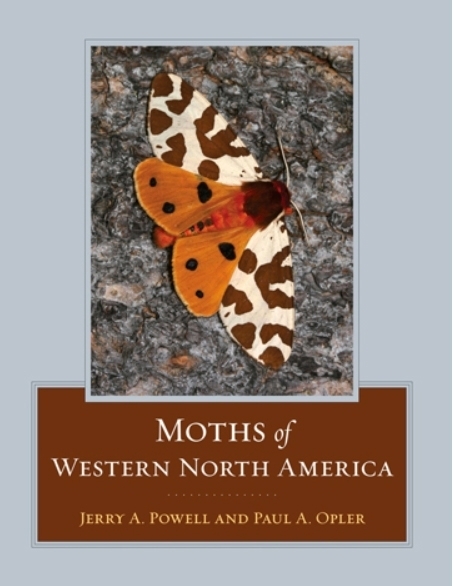
“The Mid-Winter Gathering is a legacy of Jerry Powell,” said De Benedictus, who spent more time in the field with Powell than any other UC Berkeley graduate student. "I was privileged to be Jerry's student and lucky to have him become my friend."I
In a tribute to Powell, the Essig Museum wrote: "Jerry's rearing program was the most extensive in the history of the study of New World Microlepidoptera. For over 50 years he and his students processed more than 15,000 collections of larval or live adult Lepidoptera. Resulting data encompass more than 1,000 species of moths, through rearing either field-collected larvae or those emerging from eggs deposited by females in confinement. This total includes more than 60% of an estimated 1,500 species of Microlepidoptera occurring in California."
Powell and Paul Opler, two Lepidoptera legends, co-authored Moths of Western North America.
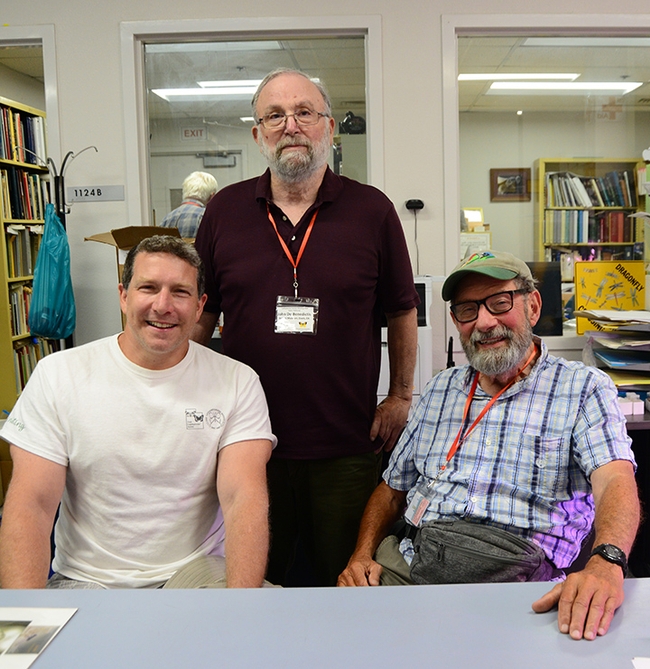
- Author: Kathy Keatley Garvey

Moths, anything about moths, was the kind of event that Powell loved. He was an associate of the Bohart Museum and a scientific collaborator, identifying scores of insects and attending many of the Leipidopterist Society meetings held there.
The open house, free and family friendly, is set from 7 to 11 p.m., Saturday, July 22 in Room 1124 of the Academic Surge Building, 455 Crocker Lane, UC Davis, campus.
Plans call for scientists to set up their traditionalblacklighting (ultraviolet or UV) display to attract moths and other night-flying insects. Bohart Research Affiliate John DeBenedictus, a retired UC Davis Staff Research Associate, also known as "The Moth Man," usually heads the blacklighting project. De Benedictus received his master's degree in 1988 from UC Berkeley, studying with Powell. "I spent more time in the field with Jerry than any other grad student," he related. "I was privileged to be Jerry's student and lucky to have become his friend."

Powell and Paul Opler (1938-2023) co-authored Moths of Western America, published in 2009.
In a tribute to Powell on its website, the Essig Museum posted in part:
"In his teen years he was heavily influenced by Charles 'Harbie' Harbison, who ran the Junior Naturalist Program at the San Diego Museum of Natural History, and sparked an interest in Jerry for butterflies and moths. Seeing his potential, Harbie recommended Jerry for the Entomology program at UC Berkeley, where he received his BS in 1955 and his PhD in 1961. While climbing through the ranks of Junior Entomologist (1961-62), Assistant Entomologist (1962-67), Associate Entomologist (1967-73), Entomologist (1973-94), Lecturer in Entomology (1964-69), Associate Professor (1969-73), and Professor (1973-94) at UC Berkeley, Jerry also became Curator (1972-2018) and Director (1993-1999) of the Essig Museum of Entomology (1972-1999) and Project Leader for the California Insect Survey (1963-1999). Although he retired as Director in 1999, Jerry remained a professor of the Graduate School until 2012 and maintained an active research program in Lepidoptera life histories and systematics until 2018, advising many students along the way. (See more on Essig website.)"
"Jerry's rearing program was the most extensive in the history of the study of New World Microlepidoptera," according to the Essig post. "For over 50 years he and his students processed more than 15,000 collections of larval or live adult Lepidoptera. Resulting data encompass more than 1,000 species of moths, through rearing either field-collected larvae or those emerging from eggs deposited by females in confinement. This total includes more than 60% of an estimated 1,500 species of Microlepidoptera occurring in California."
Powell gained international recognition when he detected the agricultural pest, the light brown apple moth, Epiphyas postvittana, in a ultralight (UV) trap on July 19, 2006 in his backyard in Berkeley.

In an email to colleagues on July 9, Peter Oboyski, executive director of the Essig Museum of Entomology, wrote: "With a heavy heart I am sad to report that professor Jerry Powell passed away this weekend. His contributions to our knowledge of California entomology, microlepidoptera, and insect life histories are inestimable, as is the value of the training he provided to his students. As one of those students, I am eternally grateful for the time, energy, and knowledge Jerry shared with me in the museum and the field."
"A consummate field biologist, Jerry's knowledge and interests were broad, allowing him to read landscapes and discover the most interesting and cryptic of species interactions," Oboyski noted. "This is well documented in over 220 publications, but also in the 60+ years of his field notes and rearing records that we are currently digitizing. He is the collector of over 400 holotypes of various insect orders, described over 170 species and 14 genera of moths, and honored by 41 patronyms. He also published papers on Hymenoptera, Coleoptera, Diptera, Dermaptera, and a Nematode. His legacy is impressive and will long be remembered."
Powell described himself as a "MothNut" on his vehicle license plate, and also displayed a sticker, "Larvae on Board."
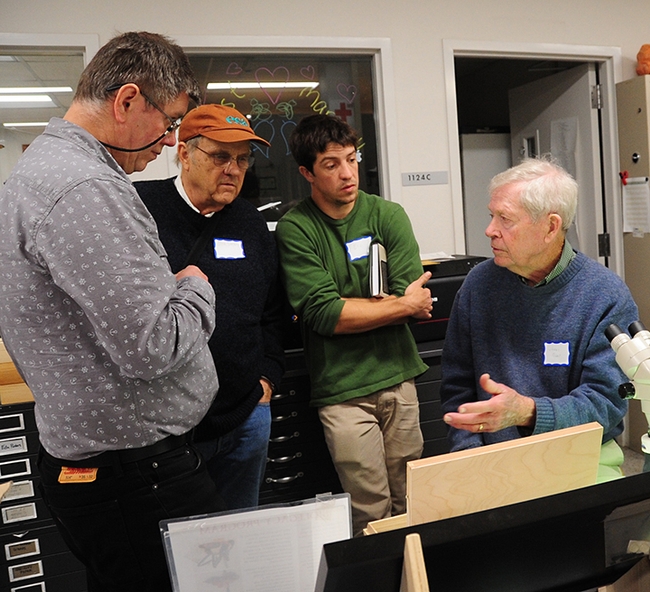
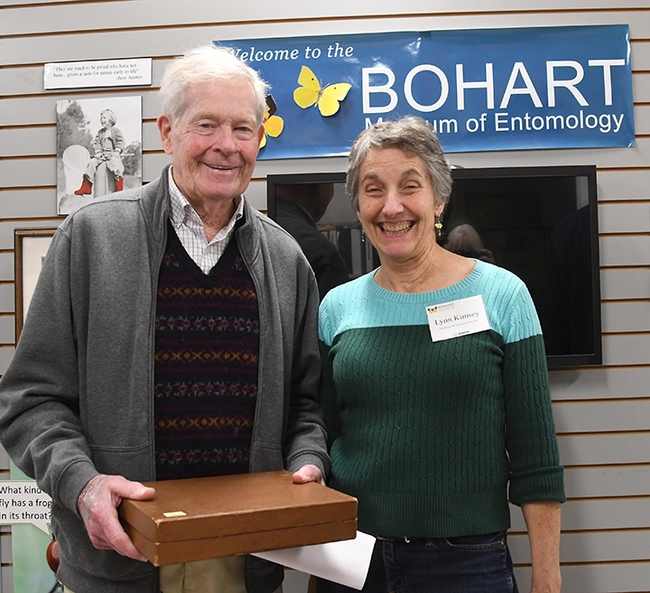
- Author: Kathy Keatley Garvey
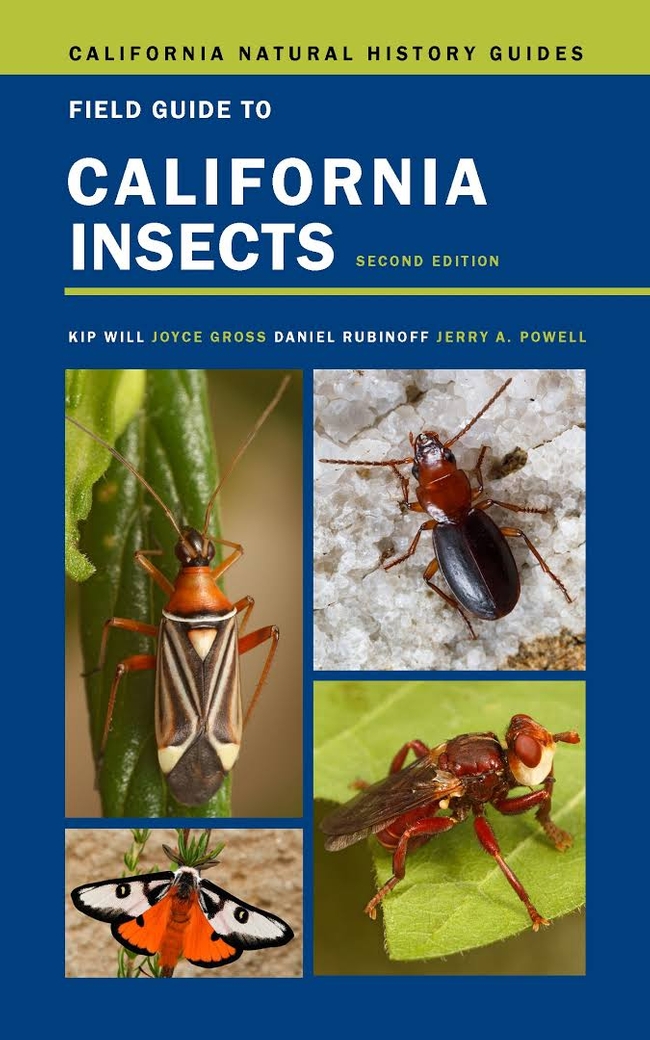
Step into your garden, walk over to a community park, or hike in the wilderness and see what's out there.
And take along the newly published, newly revised "The Field Guide to California Insects."
It includes more than 600 insect species. Not sure what species of butterfly that is? Want to know if that's a Valley carpenter bee? What's that species of praying mantis you just found? Take a look at the text and photos. Chances are you'll find them in this handy book.
It's a California Natural History Guide and published by the University of California Press. If you're into entomology, you'll probably recognize the names of the four authors:
- Kip Will, entomologist, insect systematist, and former director of the Essig Museum of Entomology at UC Berkeley
- Joyce Gross, noted insect photographer (she works as a computer programmer with the Berkeley Natural History Museums at UC Berkeley)
- Dan Rubinoff, who grew up chasing insects in California and is now a professor of entomology and director of the University of Hawaii Insect Museum
- Jerry Powell, emeritus professor, UC Berkeley, and former director of the Essig Museum of Entomology
We remember reading the first edition, California Insects, published in September 1980 and authored by Professor Powell and (the late) Charles Hogue.
So this revision is 40 years in the making.
It's billed as the only California-specific, statewide book devoted to all groups of insects:
"Engaging accounts focus on distinguishing features, remarkable aspects of biology, and geographical distribution in the state. An accessible and compact introduction to identifying, understanding, and appreciating these often unfamiliar and fascinating creatures, this guide covers insects that readers are likely to encounter in homes and natural areas, cities and suburbs, rural lands and wilderness. It also addresses exotic and invasive species and their impact on native plants and animals. Field Guide to California Insects remains the definitive portable reference and a captivating read for beginners as well as avid naturalists."
The authors point out that worldwide, there are only a million described insects, and that's "more than five times the number of all animals combined." They also note that "estimates of the number remaining to be described and named vary between three million to 30 million or more."
Thirty million! Can you imagine?
The authors define what makes an insect, expanding on growth and reproduction, breathing and circulation, feeding and stinging. They write about the distribution and diversity of the California insect fauna; how insects are classified, and even how to make an insect collection, something most high schoolers will be asked to do.
The book offers you information on dragonflies and damselflies, mantises, stick insects, beetles, fleas, flies, mosquitoes, earwigs, moths and butterflies, and booklice--and more.
It's a fantastic book--well-researched, well-written, well-illustrated, and an opportunity for you to become not a Big Game Hunter, but a Little Game Hunter.
By the end of the book, you may even decide to study entomology. (And there's plenty of opportunities in California, including at the UC Davis Department of Entomology and Nematology)
You may also want to become an insect photographer: plant a pollinator garden and they will come. Below are some of the backyard or household images you can capture.
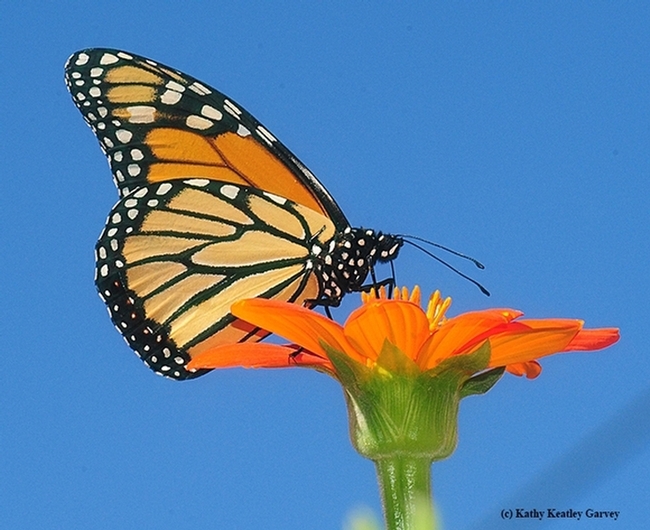
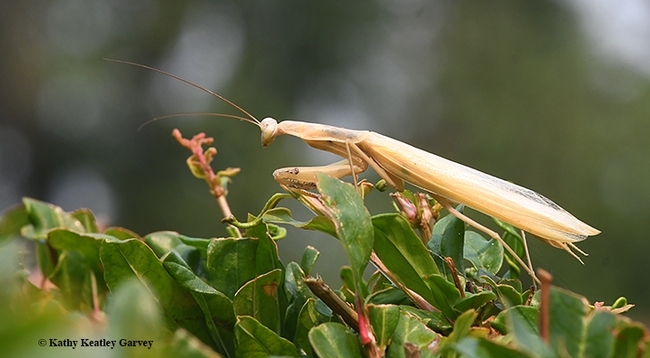
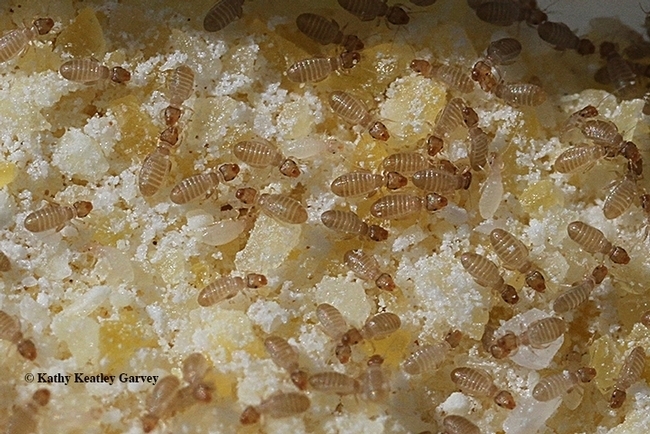
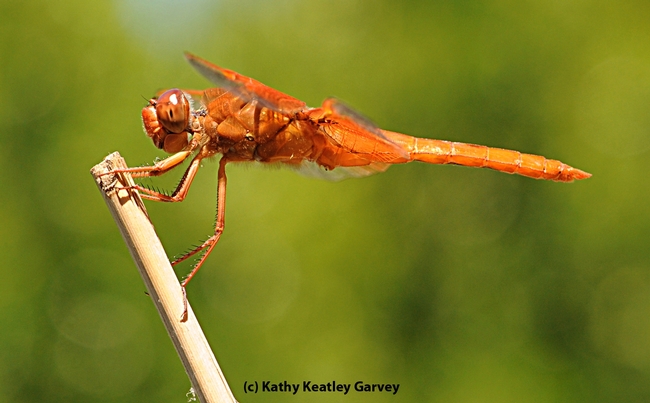
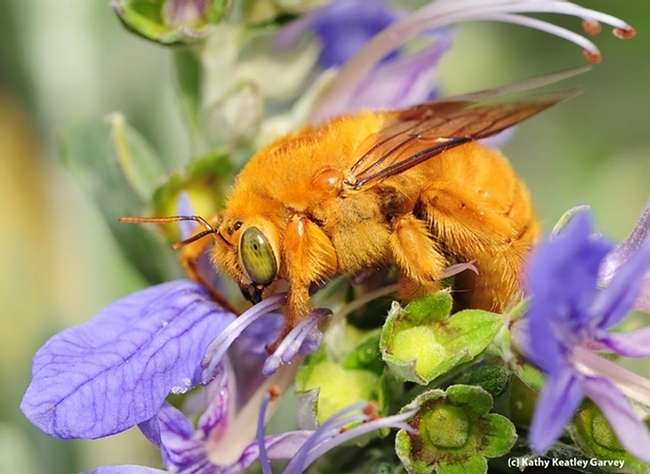
- Author: Kathy Keatley Garvey
Have you ever seen a plume moth?
Or has a plume moth ever seen you?
We spotted a pterophorid plume moth (family Pterophoridae) yesterday on our back door in Vacaville, Calif. The t-shaped moth stayed in the same spot the entire day, from dawn to dusk, even when we entered and exited the door multiple times.
Its shape is what makes it unusual. Butterfly expert Art Shapiro, distinguished professor of evolution and ecology at the University of California, Davis, told us awhile back that the "T-square shape is classic."
In some respects, the pterophorid plume moth is fit to a "T."
At rest, the plume moth holds its slender wings at right angles to body, giving it a T-shaped profile.
In his book, California Insects, UC Berkeley entomologist Jerry Powell (now emeritus) explains why they're called plume moths..."because the forewings are deeply notched and the hindwings are divided into three linear parts, each with long scale fringes. When perched, the insects roll the forewings around the folded hindwing plumes, resulting in peculiar sticklike or craneflylike appearance, unlike any other moth."
Most are nocturnal and are attracted to lights, Powell adds. (Like porch lights!)
Its ancestors lived millions of years ago. Wikipedia tells us that a fossil species from the extant genus Merrifieldia originates from the Oligocene of France. The Oligocene, a geologic epoch of the Paleogene Period, occurred 33.9 million to 23 million years ago. Today some 160 species of plume moths live in North America.
So why did the plume moth visit us? Well, it's a common moth. The adults feed on nectar and pollen (plenty of that in our pollinator garden) and caterpillars of some of the species chew the leaves of garden plants, including geraniums and snapdragons (we have both).
We also have artichokes, and the larvae of one species, the artichoke plume moth, can be a pest when the vegetable is grown as a perennial, according to the UC Statewide Integrated Pest Management Program website.
One thing is for sure: once you see the plume moth, you'll always recognize it.
